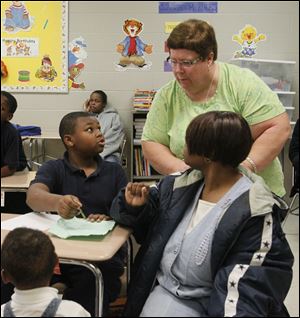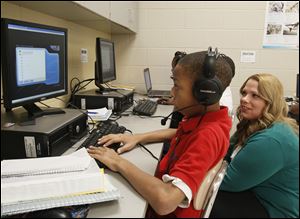
EDUCATION MATTERS
Educators at city school face steep, uphill climb
Staff takes steps to boost student test scores
11/20/2011
the blade/jetta fraser
Robinson teacher Tamra Bacon observes seventh grader Randy Martin's progress as he reads on a computer.
One in a series.

Horace Reynolds, Jr., asks teacher Nancy Young a question while his sister Shania Taylor, 2, foreground, and their mother, Maryann Taylor, attend 'Parent Power Hour' at Robinson Elementary. Inviting parents to the school once a month is one of the initiatives the school is taking in its effort to lift student performance.
They are a lonely dozen.
A team of teachers had gathered in the Robinson Elementary School library to diagnose the state of their school. Screening for reading ability was complete, and the results were in.
When they heard the news, the room went silent. Of the 180 students in grades 3 through 8, only a dozen showed they could read at their grade levels.
Although most of the students and teachers now at Robinson were at other schools last year, the analysis showed the school's state scores would have put it deep in academic emergency -- the equivalent of an F. Whether they like it or not, peer literacy coach Kris Kaser told the teachers that was their academic reality.
"We are going to live or die by these tests," she said.
In our culture of academic accountability, test scores are king. They can stain a school or make it a star.
Yet, for a school such as Robinson, much of what will show up on end-of-year tests has little to do with the school itself. Its students came from numerous schools this year, eliminating any linear path of success or failure. Any universal links consist of things beyond the school's control: the effects of poverty, poor student engagement, an unreasonably high proportion of students in special education.
But the scores are the scores, and Robinson's staff will have to do something to improve them.
EDUCATION MATTERS: The Transformation of Toledo Public Schools
Gauging progress
Every year in every school, data come at a premium. At Robinson, where the school essentiality has started from scratch, little can start without knowing where students stand.
Sue Breymaier slid an alphabet toward a young girl as the sounds of controlled chaos seeped through the closed wooden door.
Tucked into a small room off Robinson's cafeteria, the intervention assessment teacher was in the midst of a series of exercises with the kindergarten student.
Ms. Breymaier presented letters -- uppercase first, then lowercase -- to see how much of the alphabet she recognized by sight. She got all of them but "w."
Next, Ms. Breymaier showed her pictures and asked her to match the first sound of the pictured item with a list of other words. A picture of a cat should match "can," not "fork" or "book."
After a moment's hesitation, she matched the sounds.
"I told you I'm smart," she told Ms. Breymaier.
The questions were part of the kindergarten readiness assessment for literacy, used in Ohio schools to identify reading skills. Although important, the screen isn't a high-stakes test like those that appear on state school report cards. Early in every school year, students can go through an array of screens that assess their math and reading abilities. The screens can estimate grade level, whether a student might need special-education help, or diagnose where a child's struggles really lie.
And sometimes, they reveal stark realities. Like a lonely dozen students.

Robinson teacher Tamra Bacon observes seventh-grader Randy martin's progress as he reads on a computer.
New pressures
Numbers and scores had trickled through Robinson, teacher by teacher, for weeks. When teachers learned the school's figures, it was a moment for perspective, then time to get back to work.
Part of the school's strategy is regular teacher meetings at which statistics are analyzed and new techniques are developed and perfected.
After learning the school's data, teachers focused on their classrooms. They studied "cut scores," or the cutoff point of correct answers students need to reach proficiency levels on state standardized tests.
The cut scores change between grades: Students in third-grade need more correct answers than any other grade. That point wasn't lost on Principal Anthony Bronaugh, who pointed it out to third-grade teacher Sonya Loggins.
"You've got your hands full," he said. She smiled. "No pressure, though." The principal was joking, but there is plenty of pressure on Robinson.
During its previous incarnation as a middle school, Robinson constantly fell at the bottom in the district. Statewide, it ranked in the bottom 5 percent of schools, based on state standardized tests.
District leaders used the systemwide change to K-8 buildings as a chance to remake Robinson. With the help of a major federal grant, the school has been rebuilt top-down.
It has a new principal, new staff, and new students. It has new funding and more resources. And with all those new things come new pressures.
Robinson is a model. If it works, and if real improvements are made, what happened at Robinson may happen at other TPS schools. District administrators are paying close attention to the central city school.
Teaching techniques
It was a gorgeous Saturday afternoon -- too nice to be inside -- but teachers filled the Robinson library.
From 8 a.m. until 3 p.m., they practiced group energizer exercises, techniques to manage daily transitions, and worked as teams on ways to approach teaching, all at the direction of Mark Emmons, a consultant for the Massachusetts firm Responsive Classroom.
The company focuses on building up both academics and the social-emotional skills of students. Much of this year's training has been on Responsive Classroom techniques, along with a United Way-delivered social-emotional learning program.
One of the hallmarks of the programs is repeated modeling, where teachers demonstrate proper behavior for students. To internalize the concept, Mr. Emmons made teachers model many of the exercises he taught among themselves
Teachers throughout Robinson hold meetings every morning with their students before regular class work. They sit in a circle, greet each other by name, talk about a topic, share news about themselves, and play group games. The concept is meant to increase class cohesion, prepare students for the day, and develop social skills between students.
The ideas seem simple but are serious in a school like Robinson. Without an orderly classroom, time is spent putting out proverbial fires instead of teaching the math and reading skills in which students are already much too far behind.
Morning meetings have largely proved popular with teachers, and with parents, but the process isn't always smooth. Fifth-grade teacher Nancy Young asked what she should do when one child can't handle the meetings and ruins the concept for the rest of the class. Mr. Emmons told her not to kick the child out permanently but to separate him temporarily, either in a chair in the corner, out in the hall, wherever.
"I'm here to teach," he told her to say. "If you aren't ready to learn, come back and get ready."
Parent power
Flanked by his mother, Horace Reynolds, Jr., tried to keep his little sister from slipping out of the chair they shared.
Ms. Young shifted the class from its morning meeting to a math lesson, under the watchful eye of a half-dozen parents. Many kids his age would prefer their parents not sit in on their class, but young Reynolds doesn't mind his mom tagging along.
"It gives me some family here," he said at lunch later.
In most schools that serve high-poverty communities, parent engagement is minimal at best. Parent-teacher organizations are nonexistent. Interactions between teachers and parents often are limited to phone calls about discipline.
At Robinson, school staff decided to get proactive. Parents are invited into the building every month during school hours under a program called "parent power hour."
Mr. Bronaugh brought the "power hour" concept from Sherman Elementary, where he previously was principal. Robinson staff members invite parents into the school, where they shadow their children for part of the morning, then meet as a group.
There, school and district staff told parents about upcoming events and resources available. Free eye exams and glasses will soon be offered for students. College coaches are in the school. Marcus Goodwin, co-founder of the House of Emmanuel, told parents about how the group handles the school's in-school suspension program and mentors students.
"I think a lot of people throughout the city will be impressed and surprised by the parental involvement here," he said.
About 30 parents came for November's power hour; less than the estimated 50 at the last session. But staff said the program eventually will catch on. At Sherman, the school averaged about 100 parents a session by the end of Mr. Bronaugh's tenure.
Nicole Kyle, who came with her twin eighth-grade girls, said she's seen progress so far at Robinson, and she's a fan of the parent events.
"It's nice to know I can check on my kids," Ms. Kyle said.
Contact Nolan Rosenkrans at: nrosenkrans@theblade.com or 419-724-6086.